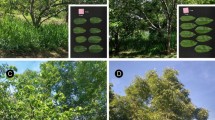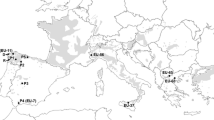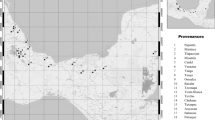Abstract
Patterns of resource allocation to growth, current reproduction, and potential future reproduction were quantified in six genetically distinct cultivars ofVaccinium macrocarpon. For all cultivars (genotypes), vegetative size is positively correlated with some measures of current reproduction (fruit and flower number) but negatively correlated with others (seed number per fruit, seed weight per fruit). Vegetative growth in the current year is significantly related to the production of reproductive terminal buds, a measure of the potential for reproduction in the following year. Stems with low levels of current reproduction — lower flower number, fruit number, and seed weight — were more likely to form reproductive terminal buds than stems with higher levels of current reproduction. Individual genotypes differed significantly for vegetative size, fruit number, fruit weight, seed number, and seed weight, as well as for the frequency of fruiting stems and reproductive terminal buds produced. Genotypes were segregated in principal component space, indicating overall differences between them in allocation to the suite of variables measured. These results indicate the possibility of fitness differences among cultivars due to genetically determined allocation strategy, which has implications for fitness differences among genotypes within natural populations.
Similar content being viewed by others
References
Abrahamson WG, Caswell H (1982) On the comparative allocation of biomass, energy, and nutrients in plants. Ecology 63: 982–991
Ackerman JD, Montalvo AM (1990) Short- and long-term limitations to fruit production in a tropical orchid. Ecology 71: 263–272
Armstrong RA (1983) On the quantitative theory of resource partitioning in rhizomatous perennial plants the influences of canopy structure, rhizome branching pattern, and self thinning. Ecology 64: 703–709
Bauman TE, Eaton GW (1986) Competition among berries on the cranberry upright. J Am Soc Hort Sci 111: 869–872
Birrenkott BA, Stang EJ (1989) Pollination and pollen tube growth in relation to cranberry fruit development. J Am Soc Hort Sci 114: 733–737
Chan BG, Cain JC (1966) The effect of seed formation on subsequent flowering in apple. Proc Am Soc Hort Sci 91: 63–68
Chaplin SJ, Walker JL (1982) Energetic constraints and adaptive significance of the floral display of a forest milkweed. Ecology 63: 1857–1870
Cipollini ML, Whigham DF (1994) Sexual dimorphism and cost of reproduction in the dioecious shrubLindera benzoin Lauraceae). Am J Bot 81: 65–75
Curtis PS, Snow AA, Miller AS (1994) Genotype specific effects of elevated CO2 on fecundity in wild radish (Raphanus raphanistrum). Oecologia 97: 100–105
Davenport JR, DeMoranville CJ, Poole AP, Roper TR, Strik BC (1991) Biennial bearing in cranberries. Cranberries, July 1991
Delph LF (1990) Sex-differential resource allocation patterns in the subdioecious shrubHebe subalpina. Ecology 71: 1342–1351
Eaton GW, Shawa AY, Bowen PA (1983) Productivity of individual cranberry uprights in Washington and British Columbia. Sci Hort 20: 179–184
Eck P (1990) The American Cranberry. Rutgers University Press, New Jersey
Galen C (1993) Cost of reproduction inPolemonium viscosum: phenotypic and genetic approaches. Evolution 47: 1073–1079
Geber MA (1990) The cost of meristem limitation inPolygonum arenastrum: negative genetic correlations between fecundity and growth Evolution 44: 799–819
Geber MA, Watson MA, Furnish R (1992) Genetic differences in clonal demography inEichhornia crassipes. J Ecol 80: 329–349
Haig D, Westoby M (1988) Inclusive fitness, seed resources, and maternal care. In: Lovett Doust J, Lovett Doust L (eds) Plant reproductive ecology: patterns and strategies. Oxford University Press, Oxford, pp 60–79
Harper JL (1977) Population biology of plants. Academic Press, San Diego
Jackson LL, DeWald CL (1994) Predicting consequences of greater reproductive effort inTripsacum dactyloides, a perennial grass. Ecology 75: 627–641
Law R (1979) The cost of reproduction in annual meadow grass. Am Nat 113: 3–16
Lubbers AE, Lechowicz MJ (1989) Effects of leaf removal on reproduction vs. belowground storage inTrillium grandiflorum. Ecology 70: 85–96
Luckwill LC (1969) The control of growth and fruitfulness of apple trees. In: Luckwill LC, Cutting CV (eds) Physiology of tree crops. Academic Press, London, pp 237–254
Meagher TR, Antonovics J, (1982) The population biology ofChamaelirium luteum, a dioecious member of the lily family: life history studies Ecology 63: 1690–1700
Meagher TR, Shaw J (1990) Clonal structure in the moss,Climacium americanum Brid. Heredity 64: 233–238
Primack RB, Antonovics J (1982) Experimental ecological genetics inPlantago. VII. Reproductive effort in populations ofP. lanceolata L. Evolution 36: 742–752
Primack RB, Hall P (1990) Costs of reproduction in the pink lady's slipper orchid: a four-year experimental study. Am Nat 136: 638–656
Reekie EG, Bazzaz FA (1987) Reproductive effort in plants. 3. Effect of reproduction on vegetative activity. Am Nat 129: 907–919
Reekie EG, Bazzaz FA (1992) Cost of reproduction as reduced growth in genotypes of two congeneric species with contrasting life histories. Oecologia 90: 21–26
Roper TR, Stang EJ, Hawker GM (1992) Early season leaf removal reduces fruit set and size in cranberry (Vaccinium macrocarpon Ait.). HortScience 27: 75
SAS Institute (1985) SAS/STAT guide for personal computers, version 6 edn. SAS Institute, Cary North Carolina
Shawa A, Eaton GW, Bowen PA (1981) Cranberry yield components in Washington and British Columbia. J Am Soc Hort Sci 106: 474–477
Silander JA (1979) Microevolution and clone structure inSpartina patens. Science 203: 658–660
Snow AA, Whigham DF (1989) Costs of flower and fruit production inTipularia discolor (Orchidaceae). Ecology 70: 1286–1293
Stanton ML (1984) Seed size variation in wild radish: effect of seed size on components of seedling and adult fitness. Ecology 65: 1105–1112
Stephenson AG (1980) Fruit set, herbivory, fruit reduction, and the fruiting strategy ofCatalpa speciosa (Bignoniaceae). Ecology 61: 57–64
Watson MA (1984) Developmental constraints: effect on population growth and patterns of resource, allocation in a clonal plant. Am Nat 123: 411–426
Author information
Authors and Affiliations
Rights and permissions
About this article
Cite this article
Elle, E. Reproductive trade-offs in genetically distinct clones ofVaccinium macrocarpon, the American cranberry. Oecologia 107, 61–70 (1996). https://doi.org/10.1007/BF00582235
Received:
Accepted:
Issue Date:
DOI: https://doi.org/10.1007/BF00582235




